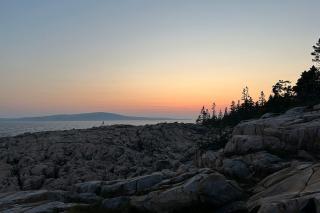Julia Rush ’24 is drawn to journalism for its “mix of creativity and ‘the rules.’” As she reflects, “I feel that journalism serves a purpose by providing one’s community with a story, news, or maybe just something funny. That is really important and it has an impact.”
In her current role, Rush is the Gero Acadia Early-Career Fellow in Science Communications for the Schoodic Institute at Acadia National Park, a scientific research organization based in Winter Harbor, Maine. She covers STEM research related to the Park and transforms otherwise esoteric insights into engaging podcasts and news articles.
Acadia National Park constitutes breathtaking natural beauty and ecological diversity. “You can see the shore, you can hike a mountain, you can go to a spruce and evergreen forest — you can do all of that in a day. It’s really special, and the sheer diversity is one of the things that draws people to Acadia,” Rush says.
“I live in Schoodic Institute housing on our campus, which is located within the park on the Schoodic Peninsula. Since it is at the very point of the peninsula, we are surrounded by an ocean on three sides, which means on most nights you can hear the surf and by morning a harmony of diesel boat engines,” Rush adds.
Communicating STEM Research
Rush enjoys the variety of tasks that her position affords. One of her principal tasks is producing the podcast, “Sea to Trees,” under the tutelage of her mentor. Given Acadia’s diverse ecosystem, which includes mountains (alpine and sub-alpine ecosystems), plants, forests, and rocky intertidal zones, the area is conducive to scientific and restoration research.
“I often go out into the field with researchers and scientists who work at the Schoodic Institute,” Rush explains. “I bring my audio recording equipment and try to gather as much audio as possible.”
Recently, Rush covered a restoration project in Great Meadow, Acadia, that involved soil coring. “I was able to meet a scientist who studies soil and pollen and can date the soil and determine what plants were growing at that time,” Rush says. Every day brings a new learning experience as well as ample time to enjoy nature.
Engaging her audience is a core aim of Rush’s work. “I try to reach people who are interested in science, but also those who don’t know about the science happening at Acadia National Park or the Schoodic Institute,” she says. “I want my content to be accessible to a wide audience [including visitors], but the focus is around science, which is part of Acadia’s mission and what sets it apart from other national parks.”
Inspiration and Hands-on Learning at Simmons
As someone who grew up in rural Maine, Rush wanted to experience her college education in an urban environment. “Boston is one of those transitional cities — it’s not as big as New York, but you still get that city experience. So, Simmons was a good choice for me,” she says.
Moreover, Rush prefers smaller schools and was drawn to Simmons’ women-centered community. “I just felt like that would be a really great opportunity to learn and feel empowered,” she says.
As someone who loved English courses in high school, Rush eventually gravitated to college coursework in the Department of Communications. One particular course Rush enjoyed was “Media Writing and Editing” (COMM 122). By her junior year, she became a communications major (with a concentration in journalism) and a business minor.
Furthermore, Rush took an art class at Simmons that proved to be revelatory. As she recounts, “I decided to take ‘Printmaking’ (Art 117) with Helen Popinchalk, and it opened me up to creativity in a way that I had not really thought about in journalistic work. It enabled me to channel that into my writing and see myself as a creative person.”
Beyond coursework, Rush’s co-curricular activities helped prepare her for her current role at the Schoodic Institute. She served as the Arts and Entertainment Editor for the Simmons Voice, the University’s student-led newspaper. She also served as the manager of Simmons Radio.
“Learning those skills in an academic setting and then having the space to apply them, like a real-world experience, was very helpful,” Rush explains. “Having a more professional role at the student newspaper gave me a big learning opportunity before going out into the [real] world. Working with the Voice and the radio station blended well with my Simmons coursework.”
For Rush, “those extracurriculars were just as valuable as the coursework for me, and I was able to use these opportunities as ways to put classroom learning into practice that were very impactful.”
Rewards of Science Journalism
Rush finds her work rewarding in several ways. Her position enables her to learn new things and share insights with the general populace.
“As someone who does not have an educational background in science, being able to be on the ground with scientists, ask them questions, and learn about what is happening in real time is such a privilege,” Rush says. Moreover, she adds, “I value the responsibility I take in telling these stories; they feel important.”
On a more personal note, Rush cherishes her return to Maine. “Since I grew up here, I feel like I am reconnecting with this place in a new way,” she says. “Also, I like the darkness and the quiet afforded by living on Schoodic Point in Acadia National Park. I love seeing the stars and the Milky Way. It’s just such a special place.”

